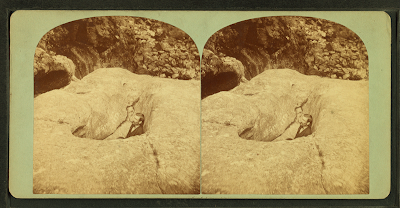Although I live in Boston my neighborhood used to be an agricultural area, and the streets near me are still lined with apple trees. There are so many apples this year they are literally rolling down the sidewalks. The Roxbury russet, the first variety of apple grown in North America, was domesticated not far from where I live now. My neighbor has a Roxbury russet tree growing in the backyard.
Apple pie is the quintessential American dessert, and I can't even begin to guess how many recipes for it exist. My mother always makes hers with a crust made from vegetable oil. The crust is really difficult to roll out, but after baking it's flaky and thin, almost like a puff pastry or phyllo dough. Delicious!
I was curious about the oldest American recipe for apple pie, so I looked at Amelia Simmons's 1796 book American Cookery. The first cookbook published in America (in Hartford, Connecticut, to be exact), American Cookery's recipes have their roots deep in New England's history. But even two centuries ago there were multiple recipes for apple pie - Simmons includes two.
The first recipe is just called "Apple Pie." Note that the "paste No. 3" Simmons references is a pastry crust recipe in her book made from flour, butter, and eggs.
Stew and strain the apples, to every three pints, grate the peal of a fresh lemon, add cinnamon, mace, rose-water and sugar to your taste--and bake in paste No. 3.
This recipe is a big change from most contemporary apple pie recipes because it involves cooking the apples first. Stewing the apples first probably sped up the baking time, which would have been helpful to cooks at that time who were baking in their fireplaces. The lemon, cinnamon and sugar are still used, but I think most people now would substitute nutmeg for mace. Mace comes from the same nut as nutmeg, but is kind of hard to find these days in supermarkets. I don't think very many people still use rose-water in their apple pie. It's just not a flavor we associate now with fall cooking.
Simmons's second recipe is perhaps a little more similar to modern recipes, but there's still a twist or two. Here's her recipe for "A Buttered Apple Pie":
Pare, quarter and core tart apples, lay in paste No. 3, cover with the same; bake half an hour, when drawn, gently raise the top crust, add sugar, butter, cinnamon, mace, wine or rose-water.
So this recipe involves putting the cut and peeled apples into a pastry crust and baking it for a while, which we still do, but strangely without any of the spices or sugar. They're are added in after the top crust is cooked enough to lift it off. Again, it seems like the recipe is designed for ovens that took a long time to cook, and it also involves rose water or wine.
OK, those are America's two oldest apple pie recipes! I think they're kind of quirky and interesting, but if you're not a baker and want to read some really strange things about apples I'd suggest these past posts:
- Some magic spells involving apples. Love magic seems popular.
- New Englanders who were killed by their own apples!
- The apple tree that ate the corpse of Roger Williams.
- A ghost who haunted an apple orchard.
Enjoy apple season while you can. It's all too brief.












